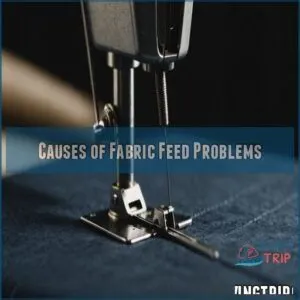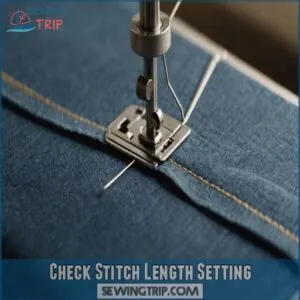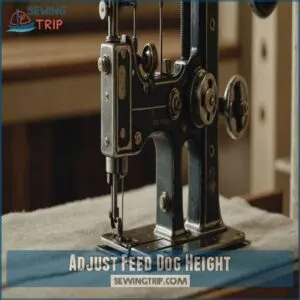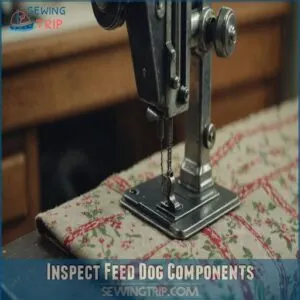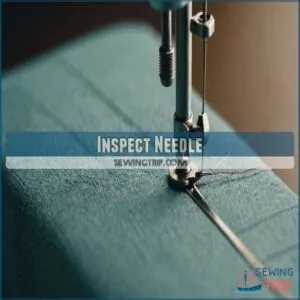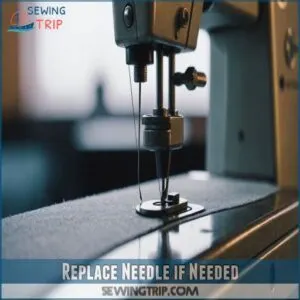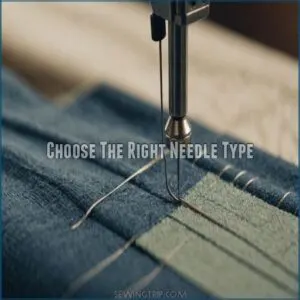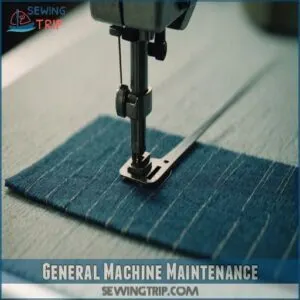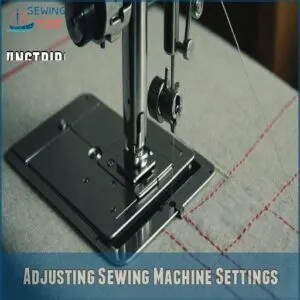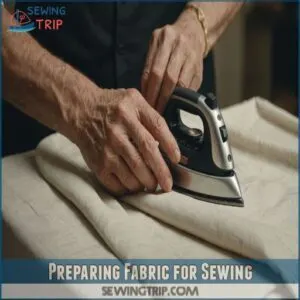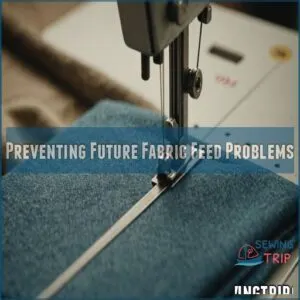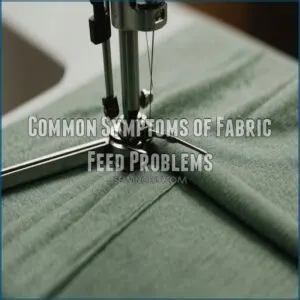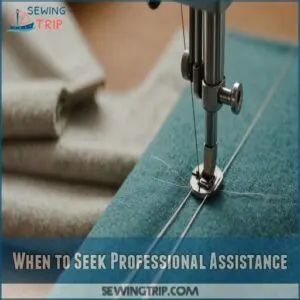This site is supported by our readers. We may earn a commission, at no cost to you, if you purchase through links.
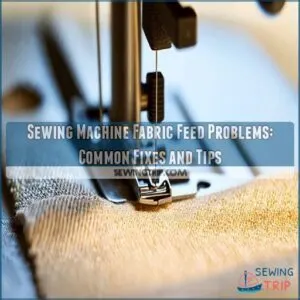
First, check your feed dogs; are they clean and raised?
A bent or dull needle is a common culprit, so inspect it carefully.
Is your presser foot down, and is the pressure right for your fabric?
Sometimes, a simple adjustment to your stitch length fixes the problem.
Remember, shorter stitches can sometimes cause feeding issues.
These easy checks often solve the issue.
But if your sewing machine’s still acting up, there are more advanced troubleshooting steps to master, leading you to become a sewing machine whisperer!
Table Of Contents
- Key Takeaways
- Causes of Fabric Feed Problems
- Troubleshooting Feed Dog Issues
- Maintaining Proper Needle Condition
- General Machine Maintenance
- Adjusting Sewing Machine Settings
- Preparing Fabric for Sewing
- Preventing Future Fabric Feed Problems
- Common Symptoms of Fabric Feed Problems
- When to Seek Professional Assistance
- Frequently Asked Questions (FAQs)
- Conclusion
Key Takeaways
- Check the needle for issues like bending or dullness since they can disrupt fabric feeding. A new, properly sized needle can solve many problems.
- Ensure the feed dogs are raised, clean, and aligned. They play a crucial role in moving the fabric smoothly through the machine.
- Correct thread tension is vital. Adjust the tension settings to prevent issues like thread looping and breakage, which can impede fabric feed.
- Regular maintenance, including cleaning and lubricating your machine, prevents lint buildup and keeps parts functioning optimally, ensuring smooth sewing.
Causes of Fabric Feed Problems
You’re not alone if your sewing machine’s fabric feed seems more rebellious than a teenager on a Monday morning.
Common culprits include needle issues, incorrect thread tension, and even something as trivial as poor fabric handling, which can turn your sewing project into a tug-of-war with your machine.
Needle Issues
When needle issues crop up, stitching can go haywire. Here’s what might be behind it:
- Bent needles throw off stitch quality.
- Wrong needle type can mess with fabric feeding.
- Incorrect needle size leads to uneven stitching.
- Worn needles drag through threads.
- Improper needle insertion creates chaos.
Avoid these traps, and you’ll keep your sewing smooth!
Upper Thread Tension
Upper thread tension can turn fabric feeding into a comedy of errors.
If your tension dial isn’t set just right, you’ll see thread loops and experience thread breakage, affecting stitch quality.
It’s important to understand the role of tension settings in achieving a balanced tension, preventing unwanted problems like thread breakage or uneven stitches.
Adjust it carefully to avoid tension issues.
Here’s a handy table to guide you:
| Problem | Solution |
|---|---|
| Thread Looping | Adjust tension dial |
| Thread Breakage | Check tension, rethread |
| Poor Stitch Quality | Balance upper thread tension |
| Uneven Stitches | Fine-tune tension settings |
| Fabric Not Feeding | Adjust stitch length, tension |
Improper Bobbin Threading
Balancing thread tension is your key to smooth sewing.
Yet, if the bobbin threading isn’t spot on, expect some hiccups.
Make sure:
- Proper bobbin case placement—aligns securely every time.
- Correct bobbin winding—neat and consistent.
- Smooth thread path—no tangles or kinks.
Every detail counts in the bobbin process!
Inferior Thread Quality
So, you’ve checked your bobbin, right?
Now, let’s talk thread.
Inferior thread quality is a sneaky culprit.
Cheap thread often leads to thread breaks, affecting stitch consistency.
Using a reputable Thread brand and the correct Thread type and weight for your fabric is key.
Think of it like this: Would you use flimsy string to build a strong bridge? No way!
Invest in quality thread for better stitch quality and fewer headaches.
Fabric Handling
When your thread quality is spot on, let’s tackle fabric handling.
Imagine herding cats—fabric can slip, bunch, or refuse to move.
Align it and check fabric tension, thickness, and weight.
Light guiding with your hands allows for smooth fabric movement along the machine, preventing feeding issues.
Remember, each fabric type handles differently; mastering this will improve your sewing journey.
Presser Foot Problems
Consider how fabric isn’t moving smoothly; it might be due to presser foot problems.
Check the presser foot height to make sure it’s not too high, allowing proper fabric movement.
Adjust foot pressure to suit the material you’re sewing.
Make sure the foot is installed and aligned correctly, as this affects compatibility with feed dogs.
Remember, each piece behaves differently under that foot.
Troubleshooting Feed Dog Issues
When your sewing machine’s fabric feed is acting up, it might just be those sneaky feed dogs misbehaving.
Start by checking the stitch length setting.
Adjust the feed dog height if needed.
Inspect components to make sure everything’s in working order.
Check Stitch Length Setting
Is your fabric not moving smoothly? Check your stitch length setting; if it’s at zero, your fabric won’t budge.
Aim for a proper length to make sure even stitching.
If you’re experiencing trouble with your sewing machine’s fabric feed, consider checking the feed dog for any potential issues.
Grab your sewing machine manual for guidance.
Watch out for:
- Stitch quality issues
- Uneven stitching
- Fabric movement problems
- Feed dog challenges
- Machine not feeding fabric
Adjust Feed Dog Height
Got your stitch length setting sorted? Let’s tackle feed dog height adjustment. Imagine tiny dancers under your fabric, magically moving it along.
If they’re too low, expect fabric feeding issues.
Raise those feed dogs for proper feed dog alignment.
Don’t forget a touch of feed dog lubrication.
Prevent your sewing machine not feeding fabric by maintaining the right feed dog height.
Inspect Feed Dog Components
After adjusting the feed dog height, you might still face fabric feed issues.
Time for a closer look!
Check your feed dogs for any signs of wear or damage, as proper maintenance is essential for maintaining smooth feed dog operation.
A little feed dog cleaning might do here.
Also, lubrication can help them move smoothly.
If they’re worn out, consider a feed dog replacement to keep things running.
Maintaining Proper Needle Condition
A bent or dull needle is a common culprit behind frustrating fabric feed problems, so regularly inspect your needle for any damage.
Replacing your needle with a fresh one, appropriate for your fabric type, helps to guarantee smooth sewing and prevents those pesky skipped stitches.
Inspect Needle
Exploring feed dog problems reveals the importance of inspecting your needle.
A bent or blunt needle can affect fabric feeding, leading to bigger headaches.
Maintain needle condition by checking for:
- Needle type: Make sure it matches your fabric.
- Needle size: Choose appropriate size.
- Bent needles: Replace immediately.
- Blunt needles: Can cause skipped stitches.
Keep your sewing smooth!
Replace Needle if Needed
If that needle’s giving you grief with skipped stitches or odd noises, it might be time to swap it out.
A sharp, new needle can solve many sewing machine problems.
Whether it’s just feeling dull or visibly bent, replacing the needle makes sure you have proper needle condition, enhancing your sewing experience.
Don’t let a tiny needle poke holes in your project!
Choose The Right Needle Type
Swapping a worn needle for a shiny new one can work wonders, but choosing the right needle type is just as key.
Match needle size with fabric weight: fine needles for lightweight fabrics, thicker ones for hefty materials.
Consider the needle point, too, as it impacts thread quality and sewing efficiency, preventing those pesky fabric feed problems.
General Machine Maintenance
Keeping your sewing machine in top shape means regularly cleaning and lubricating it and checking for lint buildup, which can cause pesky fabric feed issues.
Fabric feed issues can be a real pain, but they’re often caused by something simple: lint buildup.
Trusting your machine to feed fabric smoothly requires a bit of routine care, just like a car needs oil changes.
Clean and Lubricate
Your sewing machine’s health thrives on regular TLC.
Grab some cleaning supplies and sewing machine oil, and let’s get to work.
A maintenance schedule is essential for machine longevity.
Use lubrication tools to apply oil sparingly on moving parts.
This keeps those pesky sewing machine feed dog problems at bay, ensuring your fabric feed runs smoothly like a well-oiled machine.
Inspect Components
To keep fabric feeding smoothly, give your sewing machine a regular check-up.
Peek at the feed dog alignment and make sure it’s not playing hide and seek.
Examine the needle plate and presser foot for any nicks or dents.
Don’t forget a thread path inspection and bobbin case condition for smooth sailing, avoiding those pesky feed dog problems.
Prevent Lint Buildup
Keeping your sewing machine running smoothly means preventing those pesky lint buildups! It’s like spring cleaning, but for your machine. Regular cleaning is key to sewing machine care.
Here’s how to keep things lint-free:
- Use a soft brush to remove lint and dust.
- Clean the bobbin case regularly. Prevent bobbin lint by using a lint brush.
- Keep your workspace clean. A lint-free workspace helps.
- Employ compressed air to blast away stubborn bits. Fabric lint removal is easier.
- Use a sewing machine cleaning kit for a thorough cleaning.
Adjusting Sewing Machine Settings
When dealing with fabric feed problems, adjusting your sewing machine settings might just be the stitch in time that saves nine.
You’ll explore how tweaking the upper thread tension, bobbin tension, and presser foot pressure can make all the difference in smooth sewing.
Adjusting Upper Thread Tension
After tidying up with some machine maintenance, it’s time to tackle those looping issues.
Turn the tension dial to maintain control over thread issues and fabric weight.
Recognizing imbalanced thread tension symptoms such as uneven stitches and thread breakage is also important to achieving smooth fabric feed, often caused by incorrect thread placement, thread quality issues, or tension device malfunctions, as discussed in thread tension imbalance solutions.
If
Adjusting Bobbin Tension
Your sewing project’s success hinges on perfect bobbin tension, avoiding common fabric feed problems.
Check if your bobbin is wound evenly; uneven bobbin winding can cause tension issues.
Make sure your bobbin case is compatible with your thread type.
Adjust the bobbin tension slowly, as slight changes can greatly impact your sewing machine’s performance.
- Inspect bobbin winding
- Choose compatible thread
- Make gradual adjustments
Adjusting Presser Foot Pressure
Two adjustments can magically transform your sewing results: presser foot pressure and needle size.
Adjusting the presser foot pressure can greatly impact your sewing, especially when dealing with different fabric types, as shown in guides on how to adjust presser foot pressure Janome.
If fabric thickness or seam puckering causes fabric feed issues, tweak the presser foot pressure to balance the feed.
Too loose
Preparing Fabric for Sewing
Before you start sewing, make sure your fabric is ready to avoid pesky feed problems.
Iron out wrinkles.
Trim any extra fabric bits.
Align with the grainline for smooth stitching.
Ironing Fabric
Tuning your sewing machine settings is one thing, but ensuring fabric is prepped correctly is another.
Ironing fabric helps smooth out wrinkles and aligns it for better feeding.
Use the right ironing temperature for different fabric types, grab good ironing tools, and adjust the steam settings.
This minimizes fabric feed problems, promoting smoother fabric movement and preventing snags.
Removing Excess Fabric
With your fabric pressed, neatly trim away any excess fabric, ensuring clean cutting edges.
This pre-sewing prep step prevents fabric feed issues.
Maintain a consistent seam allowance – it’s key for preventing sewing machine jamming.
Removing excess fabric before sewing is a simple yet powerful way to avoid problems.
Think of it as giving your sewing machine a head start!
Aligning Fabric With Grainline
How do you keep fabric from fighting back while sewing? Align it with the grainline!
This guiding line runs parallel to the fabric’s selvage, ensuring smooth movement under your machine’s feed dogs.
Using the right sewing machine foot can also help, as it guides the fabric in the correct direction.
Ignoring it can cause twisted seams or skewed patterns.
Whether you’re tackling a bias cut or
Preventing Future Fabric Feed Problems
To prevent future fabric feed problems, make regular machine maintenance your new best friend, ensuring all parts are clean and functioning smoothly.
Use quality threads and choose the right needle for your fabrics, just like you wouldn’t use a spoon to cut steak!
Regular Machine Maintenance
Think of your sewing machine as a trusty steed—it needs regular grooming to run smoothly.
Set up a cleaning schedule to tackle lint and dust buildup, keeping feed dogs in action.
Use appropriate oil types and know parts replacement essentials.
Equip yourself with the right maintenance tools and a troubleshooting guide to prevent future fabric feed problems.
Using Quality Threads
Choosing quality threads is a stitch-saver, as it prevents many sewing machine fabric feed issues.
Stick with reputable thread brands like Gutermann or Coats & Clark for their reliability.
You’ll dodge thread tension headaches by ensuring your threads are correctly stored to avoid brittleness.
Plus, paying attention to thread weight helps maintain harmonious feed dog cooperation during projects.
Choosing The Right Needle
Imagine this: a perfectly fitted needle is your sewing machine’s best friend.
Choose a needle size that matches your fabric weight and type to avoid fabric feeding issues.
A sharp needle point is key, so replace dull ones.
Trust reputable needle brands for consistent quality.
Keep your needle in top shape, minimizing sewing machine problems and ensuring smooth operations.
Common Symptoms of Fabric Feed Problems
You might notice your sewing machine acting up with fabric bunching, scrunching, or even refusing to budge.
Sometimes, the thread might break or tangle more than a toddler in a yarn store.
Bunching or Scrunching Fabric
So, you’ve mastered preventing future problems? Great! Now, let’s tackle bunching. Is your fabric wrinkling up like a grumpy cat? Check your presser foot pressure; it might be too tight.
Also, consider your fabric type and weight—lighter fabrics need less pressure.
Too much speed can also cause bunching. Slow down, and let the feed dogs do their job! Remember, consistent, even feeding is key to perfect stitches.
Fabric Not Moving Through Machine
Ah, the fabric just sits there, refusing to budge! Here’s how to get things moving:
- Adjust your feed dog alignment to make sure they’re properly engaging with the fabric.
- Check the needle plate for any misalignments or damage.
- Verify bobbin tension—too tight or too loose can cause issues.
- Evaluate presser foot pressure, adapting to your fabric thickness.
Got questions? Let’s sew on!
Thread Breaking or Tangling
After solving fabric movement woes, you might face thread breaking or tangling.
Often, it’s about thread tension or a naughty bobbin winding.
Use the right needle type for your fabric type and don’t skimp on thread quality.
Check the threading path; any tangles can knot your plans.
Fix these, and watch your sewing hum along smoothly.
When to Seek Professional Assistance
If your sewing machine persists in giving you headaches with fabric feed problems despite your best troubleshooting efforts, it might be time to call in the pros.
They can handle complex issues, perform machine overhauls, and make sure everything is running smoothly, so you won’t end up with a modern art piece instead of a quilt.
Complex Machine Issues
When unusual noises start echoing, or your sewing machine feels like it’s overheating, it’s time to call a pro.
Complex issues like motor problems, electrical issues, or timing belt troubles can be beyond DIY fixes.
Ensuring your machine’s internal components are adjusted and cleaned, including the feed dog height and alignment, requires expertise.
Don’t let curiosity become a costly error!
Persistent Fabric Feed Problems
Tackling persistent fabric feed problems might require calling in the pros.
If your DIY attempts aren’t cutting it, consider these signs:
For instance, if your machine isn’t producing the desired stitch quality, you can refer to products that enhance Sewing machine stitch quality.
- Feed Dog Issues: Misalignment or wear despite proper maintenance.
- Stitch Quality:
Machine Overhaul or Repair
Finding yourself knee-deep in feed dog problems? It might be time to call in the pros.
Machines acting up frequently suggest a deeper issue, possibly beyond DIY repair.
Balance the cost of professional sewing machine repair against regular DIY maintenance; prevent hefty expenses later.
Visiting local repair shops can save your machine.
| Issue | DIY Fix | Professional Help |
|---|---|---|
| Feed dog adjustment | Yes | Maybe |
| Machine overhaul cost | High | Manageable |
| Repair frequency | Often | Less |
Frequently Asked Questions (FAQs)
What causes fabric feed problems?
Fabric feed problems can stem from low feed dogs, incorrect stitch length settings, lint buildup, or worn components.
Make sure feed dogs are clean, appropriately raised, and align with the needle plate for smooth sewing operations.
Why is my sewing machine not sewing or feeding fabric?
Your sewing machine mightn’t sew or feed fabric due to issues like incorrect threading, stitch length set to zero, feed dogs not raised, or needle problems.
Check these areas, clean your machine, and make sure it’s properly threaded.
Can you feed fabric through a sewing machine?
Imagine you’re guiding fabric through your sewing machine like a gentle river.
Make sure the feed dogs are up, stitch length is set correctly, and use consistent pressure.
This encourages a smooth journey, avoiding any sewing snags.
Why does my sewing machine keep pooping?
If your sewing machine sounds like it’s "pooping," check the feed dogs and threading for blockages or misalignment.
Often, thread jams or lint buildup can cause noisy operation.
Cleaning and rethreading usually solve these quirky machine issues.
Why is my sewing machine not moving fabric through?
Check the stitch length setting—make sure it isn’t zero.
Feed dogs should be raised and moving freely.
Clean out any debris like lint, which can jam feed dogs.
Proper height adjustment helps fabric move smoothly through.
How does a sewing machine affect stitching quality?
Your sewing machine’s a tiny artist; its settings, needle, and thread directly impact stitch quality.
A blunt needle creates skipped stitches, while incorrect tension leads to unevenness.
Proper maintenance guarantees consistent, beautiful results!
Why won’t my fabric feed through my sewing machine?
A sewing machine may not feed fabric due to incorrect stitch length, misaligned or jammed feed dogs, or threading issues.
Check that the stitch length isn’t zero.
Check that feed dogs are raised and clean.
Check that threading is correct.
Why does my sewing machine keep eating my fabric?
Fabric getting eaten by your sewing machine might be due to incorrect feed dog height.
Feed dogs that are misaligned or worn-out can also cause this problem.
Using the wrong needle type and size for your fabric can also contribute to fabric being eaten by your sewing machine.
Why is my sewing machine bunching up the fabric?
Did you know that 60% of sewing issues are linked to tension problems?
Your fabric might bunch due to loose upper thread tension, incorrect threading, or worn feed dogs.
Adjust the tension, and make sure you’re threading correctly.
Why is my sewing machine scrunching the fabric?
Check your feed dogs and stitch length; they might be causing the scrunching.
Make sure the stitch length isn’t set to zero, and that the feed dogs are clean, aligned, and raised to properly move the fabric.
How can fabric type affect feeding issues?
Imagine sewing silky satin, only to watch it slip away like a bar of soap.
Some fabrics, like silk or stretchy knits, might need extra attention with correct needle size, tension settings, and stabilizers to prevent feed issues.
What is the ideal presser foot pressure?
There’s no single ideal presser foot pressure; it depends on your fabric.
Start with the machine’s default, then adjust it slightly up or down for better fabric feed.
Experiment to find what works best!
Can thread quality impact fabric feeding?
Quality thread plays a big role in fabric feeding smoothly.
Brittle or damaged thread can break, causing uneven stitches and feeding issues.
Always invest in fresh, reliable thread from well-known brands for better sewing performance.
How does bobbin tension affect fabric movement?
When the thread tension is too loose, your fabric can slip and slide like a fish out of water.
This leads to uneven stitches.
Tighten the tension for smoother stitching, keeping an eye on any loops.
Is using a walking foot attachment beneficial?
Using a walking foot attachment helps by providing even fabric feed with its dual-feed mechanism, reducing fabric shifting, especially with tricky layers like quilts.
It’s like having a reliable friend ensuring everything stays in line.
Conclusion
When tackling sewing machine fabric feed problems, you’ve got this!
Start by checking the basics like needle condition and feed dogs.
Keep your machine well-maintained, and use quality threads to prevent issues.
Always adjust settings like thread tension and presser foot pressure to match your fabric.
If problems persist, a professional might be needed.
By mastering these troubleshooting tips, you’ll transform into a sewing machine pro, confidently tackling fabric feed challenges with ease.

